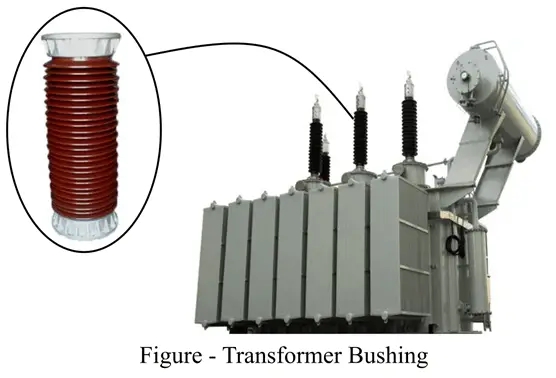In this article, we will discuss the operating principle of transformer bushing. But before that, we will look into the basics of transformer bushing.
What is a Transformer Bushing?
In electrical engineering, the term bushing is used to represent a hollow electrical insulator that helps us to safely pass an electrical conductor through a conducting barrier like a transformer case, or circuit breaker case without making any electrical connection with it.
A typical bushing is made up of porcelain. But, in practice, several other insulating materials like polymer, ceramic, glass, etc. may also be used for the same purpose.

An electric field is produced when a material carries an electric charge. Thus, when a current-carrying conductor is placed near a material at zero potential, it can increase the field strength to a very high value, especially in such cases where the electric field lines are forced to curve sharply around the material. In this situation, the bushing controls the shape and intensity of the electric field and hence reduces the electrical forces on the insulating material.
Design and Construction of Transformer Bushing
Based on design and construction, there are two types of transformer bushings: Solid Type Bushing and Condenser Type Bushing.
The solid-type bushing is also called bulk-type bushing. A solid-type bushing consists of an insulator with a central conductor and electrical-grade mineral oil is filled between the insulator and conductor. This increases the dielectric strength of the bushing.
The condenser-type bushing is also known as a capacitance-graded bushing. In the condenser-type bushing, several conducting layers are inserted at predetermined radial intervals within the insulation separating the central conductor from the insulator of the bushing. These conducting layers cause a capacitive effect in the bushing. These conductive layers are mainly provided to control the electric field around the central conductor.
Transformer Bushing Operating Principle
In the electrical power system, the windings of a transformer are subjected to high voltage of the transmission lines. Therefore, it is one of the important measures that we have to carefully insulate the current-carrying parts from the non-current-carrying parts to avoid flashover from the high voltage connection contact with the transformer body.
For this purpose, a special insulating device, called a bushing, is used. Although Bushings are not used in all types of transformers, these are primarily used in high-voltage power transformers. It is because, in the case of a power transformer connected to a power system, both primary and secondary windings of the transformer are connected to a high-voltage line.
Therefore, we need to take care of high-voltage electric fields. For this, we use bushings to provide the required insulation to the transformer terminals.
Transformer Bushing Failure
The failure of transformer bushing is one of the most important causes of failures of a transformer. The primary causes of bushing failure are – moister ingress, electrical flashover, short-circuiting of capacitance-graded layers, lightening surges, corrosive Sulphur, broken tap connection, misuse of the bushing, interrupted connection between flange and ground sleeve, etc.
Diagnosis of Transformer Bushings Failures
The following practices are to be followed in order to diagnose the conditions of transformer bushing-
- Perform tan delta test, power factor measurement, dissipation factor measurement, and capacitance measurement at the line frequency to assess the integrity of the insulation of the bushing.
- Perform capacitance measurement concurrently to assess the physical conditions of the bushing.
- Perform VFPF Test (Variable Frequency Power Factor Test) to determine the conductive contaminants, top terminals looseness, potential discharge-like issues, etc.
- Perform hot collar tests to determine deterioration, low liquid or compound levels, voids in the compounds, and contamination.
- Perform a dielectric frequency response test (DFR) to determine the bushing insulation deterioration.
Conclusion
Hence, in the above sections of this article, we discuss about transformer bushing, its construction, types, operation, failures, and diagnosis. A bushing is one of the most important parts of a high-power transformer for its successful operation in the power system. The most significant function of the transformer bushing is to insulate the high-voltage terminals from the body of the transformer.